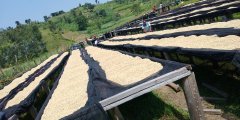Amista Coffee Manor in Costa Rica introduces the baking degree suitable for Costa Rican coffee

Professional coffee knowledge exchange more coffee bean information please follow the coffee workshop (Wechat official account cafe_style)
The quality of coffee produced in Costa Rica is the most stable among Central American countries, because Costa Rican coffee grows in suitable climate and good shading conditions, coupled with fertile soil and stable middle and later treatment, in addition, organized coffee cooperatives are closely integrated with the national coffee policy, which makes Costa Rican coffee reputation for years. At present, the treatment methods in Costa Rica are divided into two main streams: one is the traditional washing method and the other is the most popular honey treatment (Miel Process). The water treatment emphasizes that the taste is clear and clean and the acid dies like a razor, while the honey treatment emphasizes increasing the complexity and sweetness of coffee beans. The more well-known producing areas are the central valley of the Tarazu Sanshui River. However, encouraged by the coffee competition, more and more small and beautiful previously little-known estates gradually increase their popularity so that the world can taste a variety of coffee beans at different levels.
La Amistad Manor, located in Tara Pearl, Costa Rica, is an excellent manor for water extraction and washing. Coffee grows in privately owned nature reserves at an altitude of 1200-3100 meters. Amista Manor strives to protect the natural ecology. The nutrients and fertilizers for coffee come from the mixture of animal excrement and the peel, pulp and fallen leaves of coffee. The growing process strictly abides by the organic standard raw beans have been certified by OCIA International Organic Agriculture improvement Association, and Taiwan has been certified as organic raw beans by the North District Agriculture and Food Administration (organic label number is 099-1064-00001).
La Amistad Manor beans in Costa Rica, defective beans are about 3% selected by hand, weight loss ratio of roasted to light roasted (city) coffee beans is 14%, empty shell beans and bad beans account for 2%, defective beans have the same appearance and color, and the sound of crisp baking during baking is less scurf and empty shell. La Amistad Manor beans are a clean, balanced and elegant Costa Rican coffee with no unnecessary flaw pollution.
Shallow baking end (City): you can use a steeper heating curve to increase the acidity (close to the acidity of grapefruit) to show a sharp side, or you can pick a gentle warming curve to make the acidity flat, which is a good shallow baking technique. Dry aroma is vanilla aroma after cooking to give out citrus aroma, citric acid is very sharp, not muddy, taste bright, clear and vibrant, aftertaste orange sweet light, this baking degree emphasizes the acidity clean and sharp side of Amista manor.
60 seconds after baking (Full City-): a touch of berry aroma and sweetness can be smelled when grinded. After brewing, it exudes a peculiar aroma of Assam tea. The color of coffee is as red as black tea, the taste is fresh and clean, and the finish is perfectly balanced with sweetness. This baking degree mainly reflects the balance between the aroma and sweetness in the aftertaste of Amista Manor.
Re-baking second burst start (Full City): light cheese aroma is particularly obvious when grinding beans, when the fruit acid has disappeared to replace the sweetness of crystal sugar, gentle, not thick to maintain a consistent clean taste, the floral aroma of chamomile is particularly pleasant in the aftertaste.
Costa Rican coffee cultivation was introduced by Cuba in 1779 and exported for the first time in 1820. There are about 32000 coffee farmers, with an average planting area of less than one hectare (10000 hectares) per farmer. Costa Rica has a population of 41 billion (2006), with a coffee planting area of 82500 hectares and an annual production of 1.7 million bags (60kgs per bag). The annual domestic consumption is 380000 bags, with an average annual consumption of 5.5kgs per national, which is higher than that of Japan (consumption 4kgs). At present, the people of Taiwan are only slightly higher than 1kg.
END
Important Notice :
前街咖啡 FrontStreet Coffee has moved to new addredd:
FrontStreet Coffee Address: 315,Donghua East Road,GuangZhou
Tel:020 38364473
- Prev

Introduction to the Coffee Flavor characteristics of Columbia La Minita Manor, the most popular Coffee producing area
For more information on coffee beans, please follow the Coffee Workshop (official Wechat account cafe_style) Colombia has well-defined growing areas and the impressive variety of coffee they produce. Whether you want round, heavy coffee, refreshing, fruity (or somewhere in between), it's most likely to be Columbus.
- Next

Introduction to the story of the origin of Kopakama, a coffee cooperative in Rwanda. Is coffee in Rwanda expensive?
Professional coffee knowledge exchange more coffee bean information please follow Coffee Workshop (Wechat official account cafe_style) KOPAKAMA CWS KOPAKAMA is an agricultural coffee cooperative in Mabanza (former western Rwanda country). The country has been rezoned as a region, but the name still exists. Kopakama, which was founded in 1998 with only 48 members, has been committed to
Related
- Detailed explanation of Jadeite planting Land in Panamanian Jadeite Manor introduction to the grading system of Jadeite competitive bidding, Red bid, Green bid and Rose Summer
- Story of Coffee planting in Brenka region of Costa Rica Stonehenge Manor anaerobic heavy honey treatment of flavor mouth
- What's on the barrel of Blue Mountain Coffee beans?
- Can American coffee also pull flowers? How to use hot American style to pull out a good-looking pattern?
- Can you make a cold extract with coffee beans? What is the right proportion for cold-extracted coffee formula?
- Indonesian PWN Gold Mandrine Coffee Origin Features Flavor How to Chong? Mandolin coffee is American.
- A brief introduction to the flavor characteristics of Brazilian yellow bourbon coffee beans
- What is the effect of different water quality on the flavor of cold-extracted coffee? What kind of water is best for brewing coffee?
- Why do you think of Rose Summer whenever you mention Panamanian coffee?
- Introduction to the characteristics of authentic blue mountain coffee bean producing areas? What is the CIB Coffee Authority in Jamaica?

